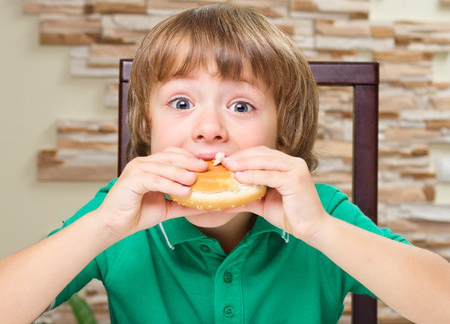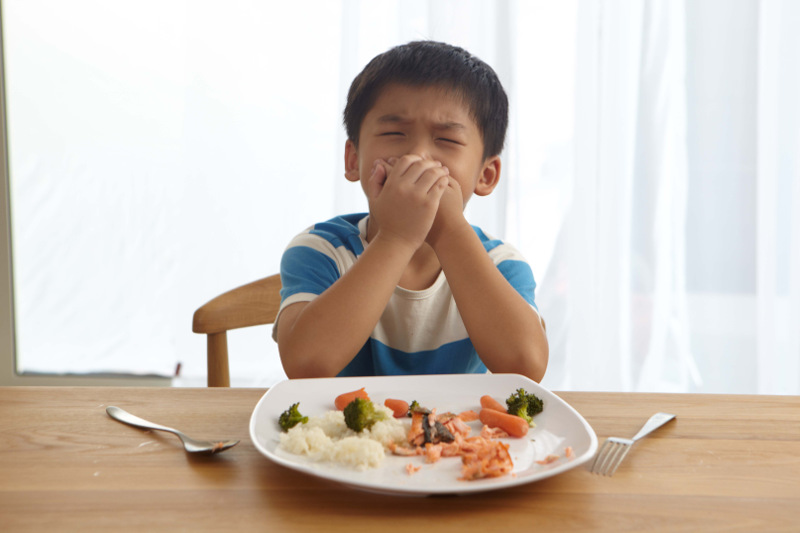One thing parents worry about is their little one’s nutrition; if they are getting a balanced diet and eating the right amount of food.
But each child’s taste, food preference and personality is different. How can parents consider these factors and provide the right nutrition?
We asked Dr Chu Hui Ping, a Specialist in Paediatric Medicine & Consultant at Raffles Children’s Centre, to suggest what types of foods parents can give to their child.
If you have a child who… is very active and always on the move

Allow the child to feed himself because in this way, he gets to participate in the feeding process and he will think that eating is a fun game. Get him to serve the food or dish out onto the parents’ plate. Also choose foods that are easy for the child to handle, such as finger foods (chicken nuggets or carrot and celery sticks with dipping sauce).
If you have a child who… is always sick

Serve the child foods that are rich in vitamins and minerals, such as citrus fruits, berries, whole grains and dark leafy green vegetables. Yogurt is also a good option because the good bacteria helps to keep the intestinal tract free of disease-causing germs.
If you have a child who… is a very slow eater
Make sure that there are no distractions during the mealtimes, such as television and iPad. Sometimes making the food more flavoured, of course in a healthy manner, can help to speed up the feeding as the child tends to be less aware of the food if it tastes too bland. Giving smaller portions and taking second helpings is also encouraging rather than having the child to face a large plate of foods. Fixing the duration of the mealtime as 30 minutes and removing the plate even if the child does not finish everything sets the rule and the child eventually realizes that he does need to speed up his eating (otherwise he will go hungry).
If you have a child who… loves to eat anything sweet

Choose foods with a natural sweetness, such as certain sweet vegetables like carrot and pumpkin, and fruits like apples and pears. If your child refuses to eat anything which is not sweet, you can incorporate these naturally sweet foods into the daily diet (for example steamed apples with oatmeal) or make it into a dipping sauce. You can also put a little honey into the cooking for the sweet flavour.
If you have a child who… eats more than two portions for each meal
Some kids do have enormous appetites and tend to overeat, which may lead to the child being overweight. Getting the child to drink a large glass of water just before eating does help to fill up the stomach with empty calories and prevent the child from eating too much. Similarly, slowing down the eating process, such as having the child to stop in between servings and walk around the house for a while, does allow more time for the child to feel full and decide that he has had enough. Serving more vegetables and whole grains also ensures that the child does not take in too many calories.
If you have a child who… eats mostly junk food

Sometimes kids love their junk food because it just seems more desirable when the parents refuse to give it to them. Depending on which type of junk food they prefer, the parent can help the child to stop taking them by actually offering even more to them. For example, if the child loves chocolates and always asks for it, the parent can just add a small slice of chocolate to their plate of food at every mealtime. It may seem like a treat in the beginning but once the child realizes that he gets to have the chocolate without him asking for it, he will slowly get sick of it and stop liking it as much. If the child loves potato chips or French fries, the healthier alternative is home-made fries, which the parent can easily make by baking the potato slices or stir-fry potato cubes coated with breadcrumbs.
If you have a child who is… rejects anything that is green

Usually, anything that is green refers to vegetables, which is not the favourite food for many kids. Parents can first introduce the taste of vegetables without them knowing by making vegetable and fruit smoothies (for example adding celery to their regular fruit smoothies) or adding a little beetroot just for the colour so that the kid does not even realize that he is drinking vegetable juice. The parent can also coat the vegetables with cheese or breadcrumbs so that the colour green does not stand out so much. Once the child is accustomed to the taste, it will be easier to accept the green foods without having to disguise it.
If you have a child who… loves to play with their food
Children who love to play with their food are usually those who are more active and on the go. Get them to do something during mealtimes, such as dishing out the foods onto the parents’ plates. Prepare foods that require some last-minute work – such as mixing in the salad dressing, or making sushi rolls with tuna and cucumber. In this way, mealtimes are interesting and the kids get to learn to handle foods in a more proper manner. Of course, if the child just wants to mess up the foods and be naughty, the parent should have some rules in place and discipline accordingly, such as standing in the naughty corner for 2 minutes.
If you have a child who… eats only when they feel like it

Parents need to set a routine so that the mealtimes are regular for their child. Having the child to decide when to eat may easily result in irregular mealtimes, more snacking and inadequate intake of proper meals. Drawing up a timetable such as a clock face showing 12 noon which indicates the time for lunch can be a visual reminder for the child during his busy playtime. If the child refuses to eat during the mealtime (i.e. give up to 30 minutes for the meal), it is alright for the child to be hungry until the next mealtime and serve only water in between mealtimes. In this way, the child learns that food is only served at fixed timings and he will go hungry if he does not eat them.
Contributed by Dr Chu Hui Ping, Specialist in Paediatric Medicine & Consultant, Raffles Children’s Centre.
Like what you see here? Get parenting tips and stories straight to your inbox! Join our mailing list here.
Want to be heard 👂 and seen 👀 by over 100,000 parents in Singapore? We can help! Leave your contact here and we’ll be in touch.
























































